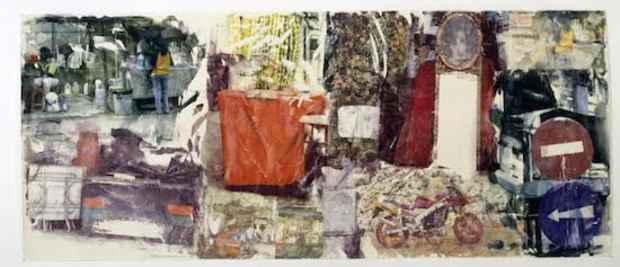Robert Rauschenberg “Anagrams, Arcadian Retreats, Anagrams (A Pun)”
The Pace Gallery (534 W 25th St)

[Image: © Robert Rauschenberg/ Licensed by VAGA, New York, NY; Photography courtesy; The Robert Rauschenberg Foundation Street "Peacock (Anagram)" (1997) inkjet dye transfer on paper, 60-1/4 x 144 in.]
This event has ended.
Pace Gallery presents the exhibition of late works by Robert Rauschenberg. The exhibition is Pace’s ninth major exhibition of work by the artist and the first since Pace began representing the Robert Rauschenberg Foundation earlier this year.
The exhibition will examine the Anagram, Arcadian Retreat and Anagram (A Pun) series. These works were created beginning in the mid-1990s, a pivotal period for Rauschenberg as he developed and perfected a powerful new technique combining dye transfer with novel supports including plaster, large-scale paper and polylaminate panels. The resulting approach would inspire the artist’s practice over the remainder of his life. A majority of the works included in the exhibition come from Rauschenberg’s personal collection, which now makes up the holdings of the Robert Rauschenberg Foundation. A new catalogue with an essay by art historian Jonathan Fineberg will accompany the exhibition.
Rauschenberg—one of the seminal figures in the history of 20th century art—sought to challenge existing parameters of art in his practice, blurring media distinctions and ultimately the boundaries between art and life. An inveterate inventor, he consistently reevaluated his approach to materials and techniques throughout his life, and his improvisational methods destabilized the established frameworks of modernism. Rauschenberg’s groundbreaking work of the 1950s and 1960s preceded Pop art and Neo-Dadaism, and much of the Minimalist and Conceptual art of the last five decades is enormously indebted to Rauschenberg’s early discoveries. Pace’s exhibition highlights the significance of innovation in Rauschenberg’s work and the advent of the last major development of his prolific career.
For the Anagram, Arcadian Retreat and Anagram (A Pun) series, Rauschenberg drew upon the achievements of his early screen print and image transfer works of the 1950s and 1960s while reinvigorating the ideas, imagery and techniques to respond to a dramatically different world. These works were characterized by the advent of a water-soluble inkjet dye transfer process that gave him greater flexibility in the scale of his paintings. This process produced an aqueous and fluid appearance, blurring the crisp edges of his photographs and recalling the process of his work from the 1960s and 1980s. The inkjet dye process also liberated Rauschenberg from the mechanical production of printing screens, allowing him to produce sheets exclusively from his own photography on an in-studio printer. In addition to a more painterly effect, these works reflect a more nimble and freer app roach to image-making than earlier works which were bound by the limitations of mechanical processes.
The works on view continue the improvisational juxtapositions that are a signature of Rauschenberg’s earlier work and suggest the act of channel surfing with their energy and visual diversity. Influenced in part by his extensive international travels in the 1980s and early 1990s, the works engage the artist’s global perspective and evince his singular ability to transform sights into personal visual poetry.
Robert Rauschenberg (b. 1925, Port Arthur, Texas; d. 2008, Captiva, Florida) emerged as one of the most significant figures of postwar American art. Following his studies at Black Mountain College, Rauschenberg created a series of seminal monochrome paintings and continued to challenge assumptions about the essence of painting with his Combines (1954–64), which paved the way for Pop art as well as new directions in assemblage and painting. Also in the 1960s, Rauschenberg was an early innovator of screen printing and later explored technology with Experiments in Art and Technology (E.A.T.). In 1970, he established Captiva, Florida, as his primary residence though he remained active in New York and abroad, working with artists an d choreographers as well as lawmakers, pushing his belief in art as a vital force in ushering in a better world.
In 1990, Rauschenberg established his eponymous foundation to further his lifelong goals of effecting social change through his art. Today, the Robert Rauschenberg Foundation works to preserve this mission, supporting social causes such as education and the environment, fostering artistic practices through grants and residencies and cultivating scholarship and awareness of Rauschenberg’s work and legacy. The Foundation is jointly represented by Pace; Galerie Thaddeus Ropac, Paris and Salzburg; and Galeria Luisa Strina, São Paulo.
During his life, Rauschenberg’s work was the subject of numerous solo exhibitions and was included in significant group exhibitions including Documenta and the Venice Biennale, where he was awarded the International Grand Prize in Painting in 1964. His work is represented in more than one hundred public collections.
In November 2016 the Tate Modern, London, will present the first retrospective of Rauschenberg’s work since his death. The exhibition will travel to The Museum of Modern Art, New York, and the redesigned San Francisco Museum of Modern Art. The most recent career retrospective of Rauschenberg, curated by Walter Hopps and Susan Davidson for the Solomon R. Guggenheim Museum in 1997, traveled to the Guggenheim Museum, Bilbao; Museum Ludwig, Cologne; and Houston’s three major museums: the Contemporary Arts Museum, The Menil Collection and Museum of Fine Arts.
Media
Schedule
from October 23, 2015 to November 12, 2015
Opening Reception on 2015-10-22 from 18:00 to 20:00